James Green, 1855 - 1935
by Brian Stevenson
last updated July, 2014
Amateur
microscope slide-maker James Green specialized in mounting foraminifera, likely
inspired by the expansive deposits of foraminiferous near his home in March,
Cambridge, England. While still a teenager, Green traded local foraminifera for
similar material from other parts of the world. Those exchanges presumably
account for the variety seen among his prepared slides (Figure 1). Although the
labels on Green’s slides are of professional quality, I have not found any
evidence to suggest that he sold his preparations. These are probably examples
of the “first-class slides” he
offered in magazines to exchange for raw material or other slides. Green was a
Fellow of the Royal Microscopical Society, and was likely to have also swapped
slides with those colleagues.
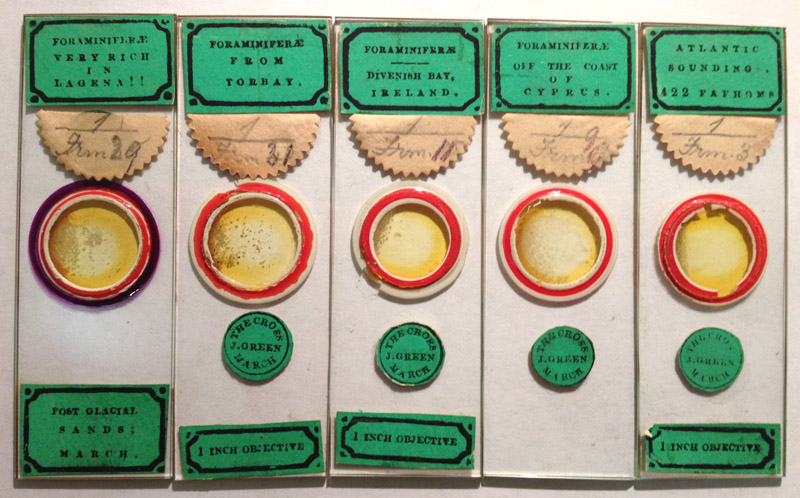
Figure 1.
Examples of microscope slides prepared by James
Green. He was collecting and preparing foraminifera from local deposits by the
early 1870s, and advertised to provide “first class slides” in exchange offers
from 1879 onward. The slide on the left contains foraminifera from “post
glacial sands: March”, the deposits near Green’s home. The other slides contain
materials that were likely obtained in exchange for his March foraminifera.
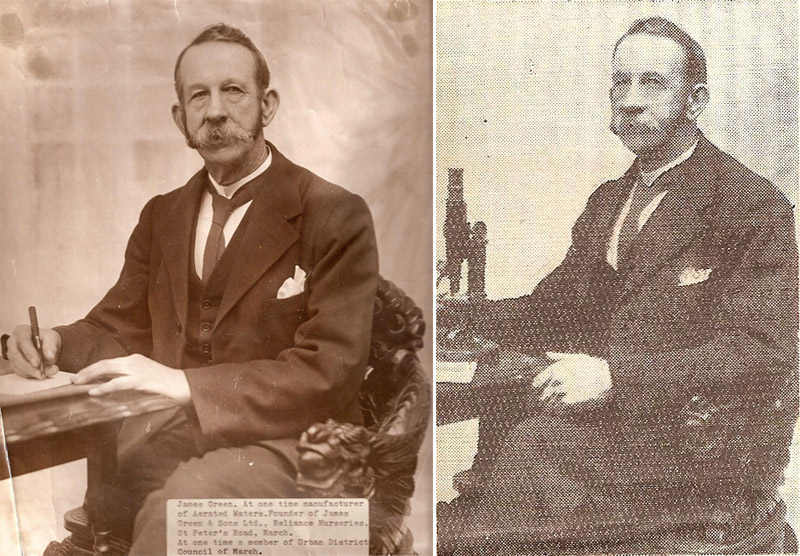
Figure 2.
Undated photographs of James Green. The left picture
is on display at the March and District Museum, March, Cambridge. The picture
on the right is from the 1935 obituary that appeared in the local newspaper. Both
pictures, and most of the other illustrations in this essay were generously
provided by Richard Munns of the March and District Museum.

Figure 3.
The display of James Green’s microscopes, slides and
other material, which is on display at the March and District Museum, March,
Cambridge. The slide cabinet, on the bottom, is likely as used by Green
(although it may have since been painted). Courtesy of Richard Munns and the
Museum.
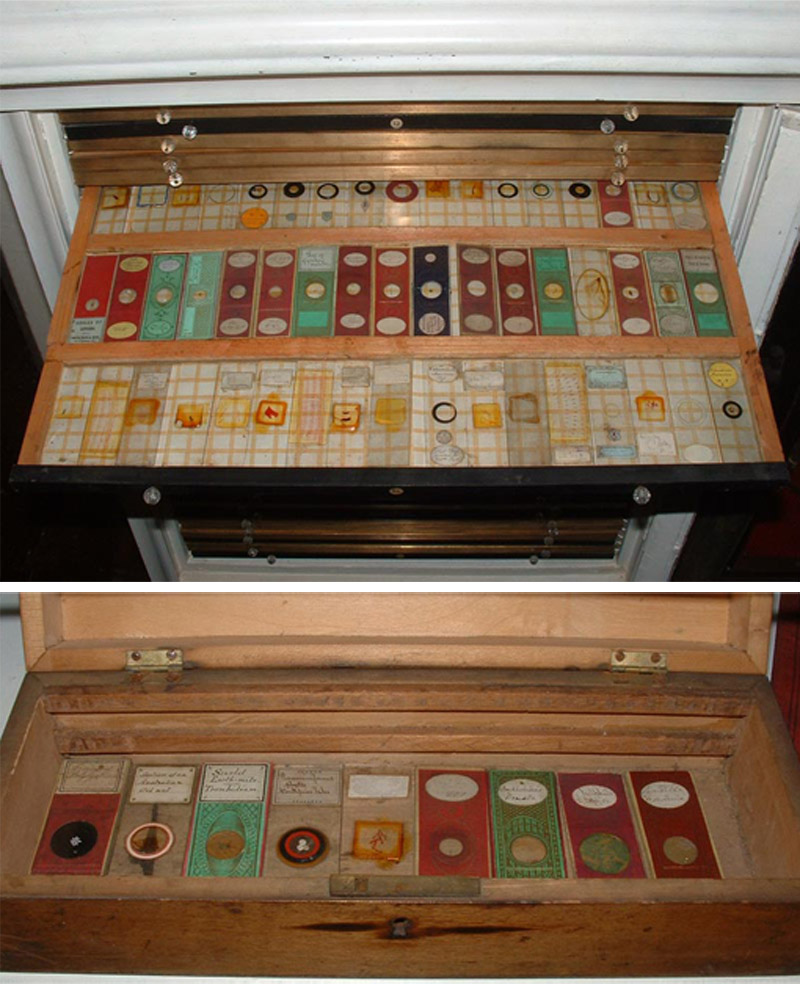
Figure 4.
Some of James Green’s personal collection of
microscope slides. Recognizable among these are preparations by mid-to-late-1800s professional
slide-makers John Norman, Cornelius Poulton, Charles Topping, Amos Topping,
Joseph Bourgogne, and an unidentified professional nicknamed “Green Papers”.
Many of these slides were probably acquired by Green in exchange for his own
foraminifera slides. Courtesy of Richard Munns and the March and District
Museum.

Figure 5.
James Green’s record of his personal collection of
microscope slides. Courtesy of Richard Munns and the March and District Museum.
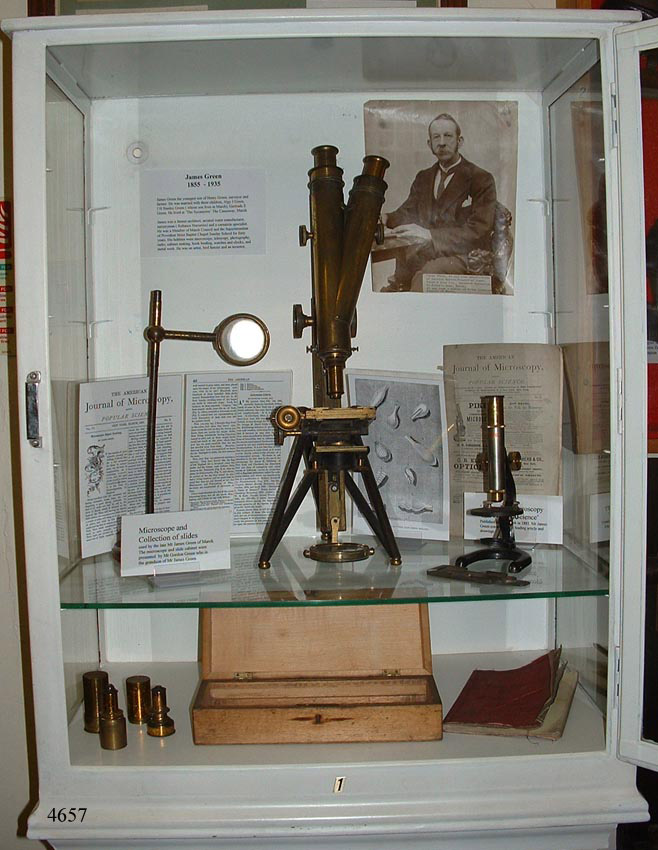
Figure 6.
Two of James Green’s microscopes, a bull’s eye condenser,
two objective lenses and other material on exhibit at the March and District
Museum. The photograph of Green is also shown in Figure 2, above, and the
article he published in the ‘American Journal of Microscopy’ is reprinted below
as Figure 9. The large microscope in the center is a ca. 1860s “Student
Microscope” by William Ladd. Pictures of another such microscope can be seen at Alan Wissner’s excellent web site, http://www.antique-microscopes.com/photos/ladd.htm. Courtesy of Richard Munns and the Museum.
James
Green was born during the early months of 1855, in March, Cambridgeshire. His
father, Henry, was a farmer – the 1871 census reports that he held 72 acres and
employed 8 men, 7 women and 3 boys.
James
evidently became interested in foraminifera and slide-making as a teenager. In
mid-1874, the 19 year-old Green advertised in Hardwicke’s Science-Gossip, “For
packet of Foraminiferous Silt, partly prepared send
mounted object of interest to J. Green, Causeway Villa, March
Cambridgeshire”, and “For Packet of
Pure Foraminiferous Shells, send good Mounted object of interest to James Green, March”. That year,
he also wrote to The English Mechanic and
World of Science, “Foraminifera
in Silt - Silt is obtainable here (March, Cambs.) in almost any quantity, and
as it contains numerous ‘shells’, and some that I have not seen in sponge-sand,
I shall be happy to send some of it to any person who will send a stamped
addressed envelope to J. Green, Causeway Villa,
March, Cambs. It is partly prepared, by sifting, to lessen the bulk”. The
editor of English Mechanic commented,
“Mr. Green has been good enough to send me some of the sand, and I find that
his estimate of its interest is rather underdrawn. The sand contains several
very interesting foraminiferae. I will suggest to those who apply for the sand
that they comply with Mr. Green's request literally, and both stamp and address
the envelope - not merely inclose stamp with or without an envelope”.
The next
year, Green began exchanging his material for others, enabling production of
the varied slides shown in Figure 1. An exchange offer in an 1875 Hardwicke’s Science-Gossip asked, “Wanted at once six or ten ounces of
unprepared Foraminiferous Soundings, Dredgings, or
other good material preferably recent, for pure Foraminifera
or two Slides.- J. Green, March”. The
following year, he ran, “Offers requested
for one scruple weight of prepared Foraminifera.
Wanted, Foraminiferous sand. - J. Green, the Cross, March”. In 1879, he requested in the American Journal of
Microscopy, “To mounters: Large
quantities of pure foraminifera, etc., for first class prepared
American material, send samples to J. Green, The
Cross, March, England”.
He also
requested other material for his collection. In 1878, he posted, “Number of first class Anatomical Slides
wanted, for first slides or material; send sample and list for sample and list
to James Green, the Cross, March”. In 1879, “Wanted, good micro material, prepared or in the
rough - Foraminifera, Polycystina, Spicula, Diatoms,
E. spines, &c., for first-class slides. - James Green, the Cross, March”.
James’
father died in 1877. The only son, James took over his father’s farm. The 1881
census recorded 26 year-old James as being a “market gardener and farmer of 43 acres employing 5 men and 6 women”,
and living with his mother.
Also in
1881, James published a brief article in The
American Journal of Microscopy on the topic of “microscopic object hunting”. This essay on collecting foraminifera
was accompanied by a professional engraving of some of Green’s findings. Both
the essay and picture are reproduced below in Figure 9.
Green also
described the March foraminifera beds in an 1881 issue of The Journal of the Royal Microscopical Society, “In various parts of the fens of Cambridgeshire, but more particularly in the district
known as the Isle of Ely, may be found considerable beds of silt, which give a
slightly undulating surface to what would otherwise appear as a perfectly level
plane. These banks are generally covered with from one to two feet of the
ordinary black vegetable mould, for which these fens are particularly famous.
Occasionally the silt crops out, and where this is the case it almost assumes
the same colour as the surrounding earth. The height of the banks rarely
exceeds four or five feet. In the town of March there
is a fine sample of one of these silt banks, which has been opened, and large
quantities of the silt taken away by brickmakers, to prevent the newly made
bricks from adhering one to another before being dried and burned. They have
left a large semicircular section of the silt upstanding, somewhat like a wall
some four or five feet in height. The beds rest, in most cases, on blue clay,
which extends downwards, as far as any local borings have ever been made, some fifty
or sixty feet. On carefully examining the section, one may trace thin sinuous
lines of a black or greyish tint, running in a nearly horizontal direction,
resembling the ripples left on the sand at the sea-shore. The lines were
apparently formed in some such manner, as on examining them with a powerful
hand-lens large numbers of Foraminifera are seen, which are, in fact, almost
exclusively confined to the sinuous lines, the bulk of the silt itself (which
is of the colour of yellow ochre) containing none. These greyish lines consist
for the most part of shells, fine sand, black specks of what seem to be
lignite, and other decayed matter, such as one would expect and would find in
the ripples by the shore. Mr. Green adds that if any difficulty is found in
getting heavy shells to swim by the floating process, strong brine will often
accomplish what the fresh water fails to do”.
James
married Mary Johnson in 1885. Together, they had three children. Their two
sons, Algernon and John, later took over their father’s businesses. Around the
time of the marriage, the couple moved to “The Orchards”, on St. Peter’s Road,
March. At this time, he began a plant nursery business. He also operated an
aerated water and flavored soda water business (Figure 7). Mary died in 1893,
at the age of only 38.
An 1895
exchange offer from James suggests that he had dropped out of microscopy for a
while, “Wanted,
first-class microscopic slides for others, each on approval. I would be glad to
correspond with my old friends of a few years back. - James Green, St Peter's Road, March”.
James
remarried in the early summer of 1901, to Lydia Shepperson. They moved to “The
Sycamores”, a home designed by Green (Figure 8). Although he had no formal
training in architecture, James designed several buildings in the March area.
He focused his nursery business on growing carnations, and, by the time of his
death, had two acres of greenhouses dedicated to that flower.
James
retired from his businesses around 1920, passing them on to his two sons. Lydia
died in 1934, and James followed the next year, passing away on November 9,
1935.
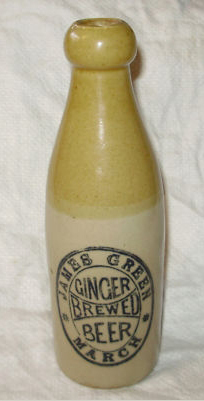
Figure 7.
A James Green ginger beer bottle. Image from an internet auction site.
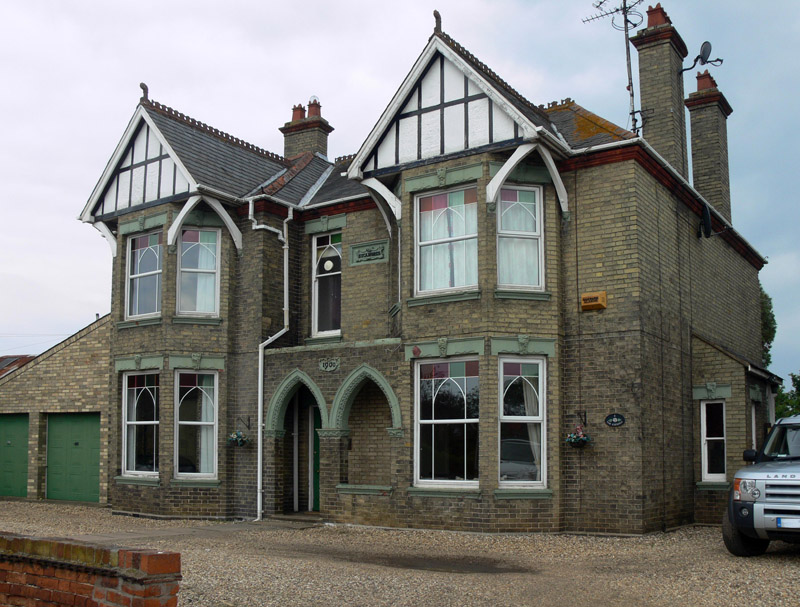
Figure 8.
“The Sycamores”, designed by and the home of James
Green and family from ca. 1901. Courtesy of Richard Munns and the Museum.
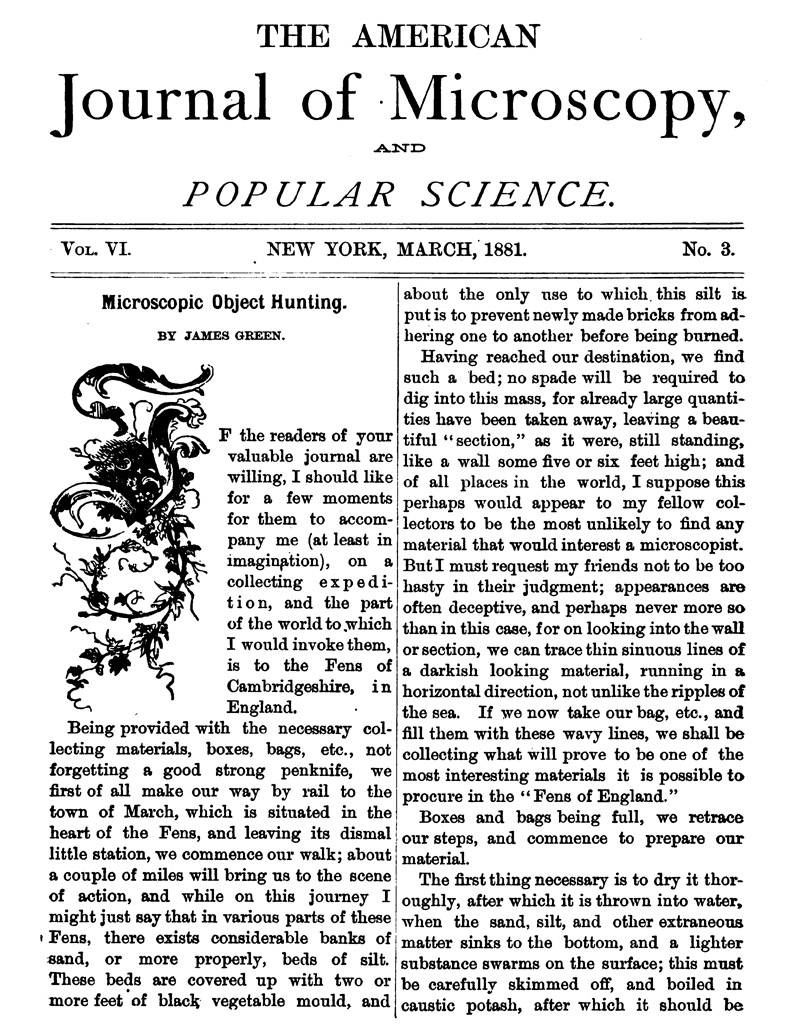
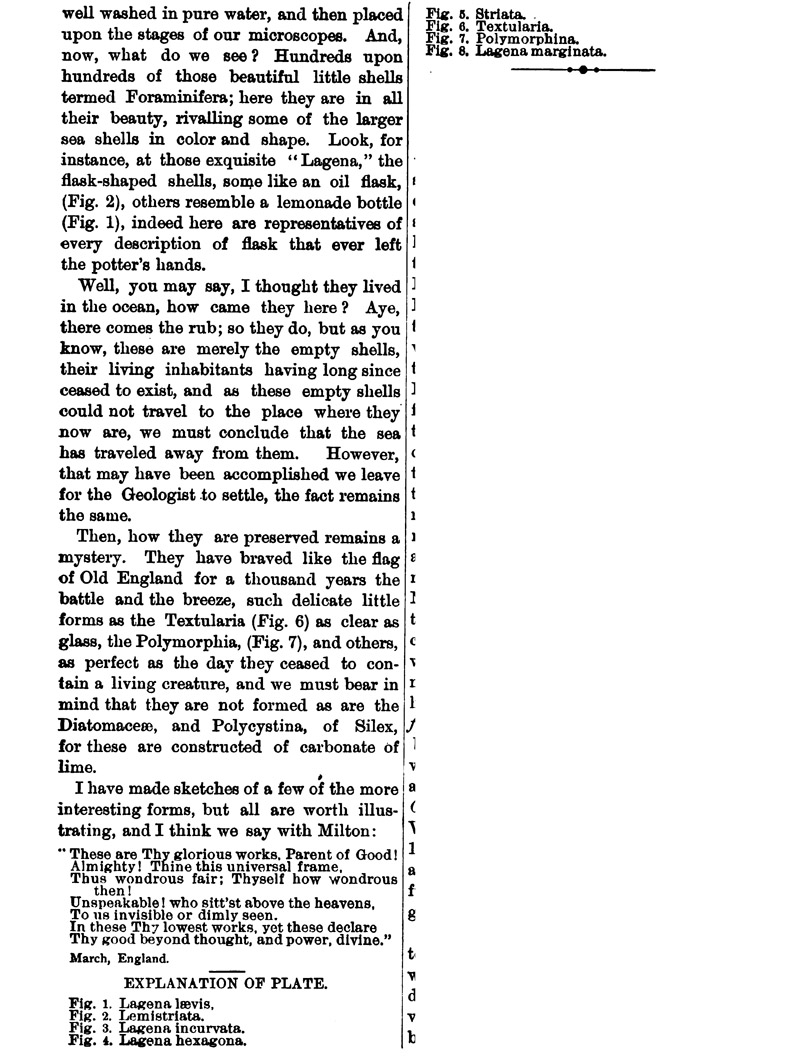
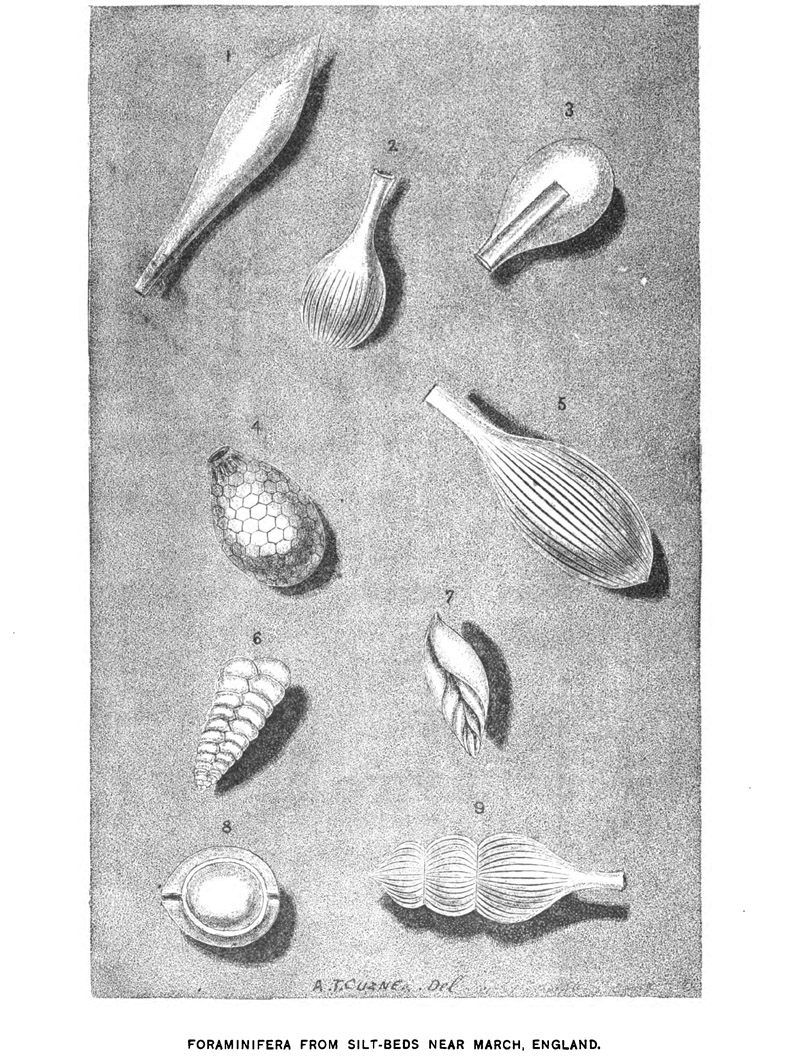
Figure 9.
James Green’s article on “Microscopic Object
Hunting” and accompanying illustration, from ‘The American Journal of
Microscopy’, March, 1881.
Acknowledgements
Many
thanks to Richard Munns and the March and District Museum for generously
providing pictures and information. The Museum’s web site is http://www.marchmuseum.co.uk.
Resources
American Journal of Microscopy (1879)
Exchange offers from James Green, Vol. 4, pages 188 and 232
England
census, birth, marriage, death and probate records, accessed through
ancestry.co.uk
English Mechanic and World of Science (1874)
Exchange offer from James Green, Vol. 19, page 229
Green,
James (1881) Microscopic object hunting, American
Journal of Microscopy, Vol. 6, pages 45-46
Hardwicke’s Science-Gossip (1874)
Exchange offers from James Green, Vol. 10, pages 216 and 284
Hardwicke’s Science-Gossip (1875)
Exchange offer from James Green, Vol. 11, page 240
Hardwicke’s Science-Gossip (1875)
Exchange offer from James Green, Vol. 12, page 284
Hardwicke’s Science-Gossip (1878)
Exchange offer from James Green, Vol. 14, page 240
Hardwicke’s Science-Gossip (1879)
Exchange offer from James Green, Vol. 15, page 216
Journal of the Royal Microscopical Society (1881)
Foraminiferous silt banks of the Isle of Ely, Series 2, Vol. 1, page 473
March
& District Museum (accessed July, 2014) http://www.marchmuseum.co.uk
Obituary
of James Green (1935) provided by Richard Munns
Probate of
Henry Green (1877) “The Will of Henry
Green late of March in the Isle of Ely and County of Cambridge Farmer and
Potato Merchant who died 29 October 1877 at March was proved at Peterborough by
James Green Market Gardener and William Scargell Cabinet Maker both of March
and William Morton of Grandford House March Farmer the Executors”. Accessed
through ancestry.co.uk
Science-Gossip (1895) Exchange offer from James
Green, Series 2, Vol. 1, page 224










